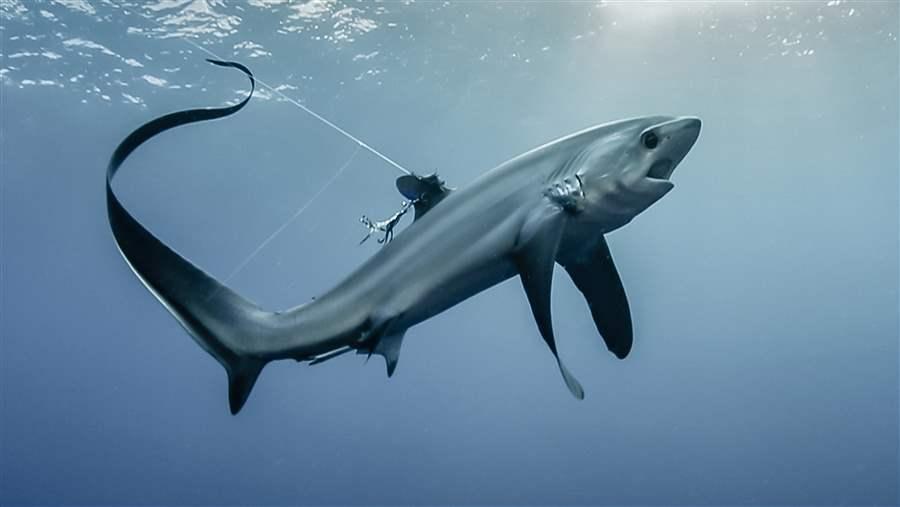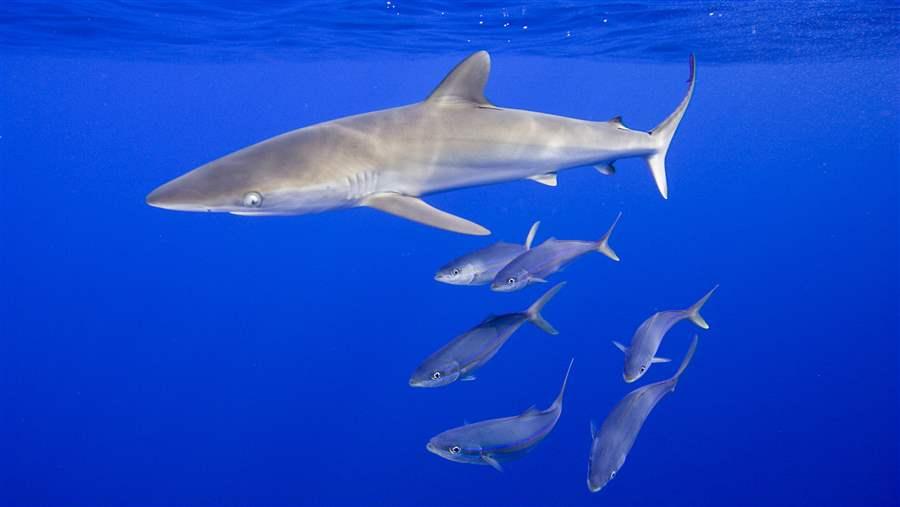The 11th Meeting of the Conference of the Parties to the Convention on the Conservation of Migratory Species of Wild Animals
Quito, Ecuador, 4–9 November 2014
 © Shawn Heinrichs
© Shawn HeinrichsPelagic thresher shark caught in fishery.
Protecting migratory marine species and their habitats is a critical component of efforts to ensure the health of the world’s oceans. The Convention on the Conservation of Migratory Species of Wild Animals (CMS) is uniquely placed to take on this task.
At this 11th Meeting of the Conference of the Parties to CMS (COP11), The Pew Charitable Trusts urges that progress be made to advance the conservation of migratory shark and ray species, raise the importance of networks of marine protected areas for migratory species, reduce marine debris, and improve the overall functioning and effectiveness of the Convention.
Pew sees the listing of additional shark and ray species on the CMS Appendices as the top priority for COP11. Listings that encourage coordinated management to conserve species are an essential response to the severe population declines suffered by migratory sharks and rays worldwide—and the paucity of effective management in place to protect them. The governments of Egypt, the European Union, Costa Rica, Ecuador, and Fiji have
led the way by submitting proposals for listing the silky shark, three species of thresher shark, two species of hammerhead shark, the reef manta, and all species of mobulid ray for consideration.
Recommendations
Conservation of migratory sharks and rays
Pew calls on CMS Parties to adopt these proposals and, through Appendix I and II listings, to develop better international management for these rapidly declining species and strengthen domestic protections.
Overfishing is taking its toll on many shark populations around the world. In general, sharks grow slowly, mature late, and produce few young over long lifetimes. That leaves them especially vulnerable to overexploitation and slow to recover from depletion.
The demand for shark fins, meat, liver oil, and other products has driven declines in populations worldwide. It is estimated that more than half face some elevated risk of extinction due to overfishing: At least one-quarter of sharks and rays are threatened, and well over one-quarter are Near Threatened.1 Every year, about 100 million sharks are caught and killed in commercial fisheries, an unsustainable number.2 Whether this catch is unintended, unwanted, or highly sought after, the resulting effect on ocean ecosystems demands urgent action.
Sharks are at risk. Until measures are in place to ensure that the targeted and incidental catch of sharks is sustainable, their capture in fishing gear should be avoided and they should be released alive whenever possible.
Pew calls on all CMS parties to support adoption of the following proposals:
- The inclusion of the silky shark (Carcharhinus falciformis) in CMS Appendix II.
Proposed by Egypt (UNEP/CMS/COP11/Doc.24.1.14).
Worldwide, silky sharks are one of the shark species most frequently caught in tuna longline and purse seine fishing gear. This high level of fishing pressure has led to the rapid decline of silky sharks wherever they are found, as noted by scientific research, fisheries stock assessments, and ecological risk assessments conducted throughout their range.3
As noted in Egypt’s proposal, this species is highly migratory, lacks proper management throughout its range, and has declined by more than 90 percent in the past 40 years in some waters.4 The CMS Scientific Council analyzed Egypt’s proposal and endorsed it, recommending that CMS Parties adopt the proposal to list the silky shark on CMS Appendix II.
As such, it is imperative that the species be added to CMS Appendix II and that, as a result, the species become a priority for international conservation and management action throughout its range.
- The inclusion of all species of thresher sharks, genus Alopias, in CMS Appendix II.
Proposed by the European Union and its 28 Member States (UNEP/CMS/COP11/Doc.24.1.17).
Thresher sharks are highly migratory. They are found regularly on both the high seas and in countries’ territorial waters closer to shore. Thresher sharks are frequently and unsustainably caught as bycatch in tuna and swordfish longline and gill-net fisheries. They also are targeted in some parts of their range.5
As noted in the European Union’s proposal, thresher sharks have limited protections throughout their range. Populations have declined severely wherever they are found because of overfishing and inadequate management.6 Estimates indicate a decline of more than 99 percent in abundance of common thresher sharks in the Mediterranean Sea in just over 100 years.7 Overexploitation has resulted in the bigeye thresher being classified by the International Union for Conservation of Nature (IUCN) Red List of Threatened Species as Endangered in the northwest and western and central Atlantic Ocean.8
Noting these declines, the CMS Scientific Council endorsed the EU proposal, recommending that all species of thresher shark be listed on CMS Appendix II.
As such, it is imperative that the species be added to CMS Appendix II and that, as a result, these species become a priority for international conservation and management action throughout their range.
- The inclusion of the great hammerhead shark (Sphyrna mokarran) and the scalloped hammerhead shark (Sphyrna lewini) in CMS Appendix II.
Proposed by the governments of Costa Rica and Ecuador (UNEP/CMS/COP11/Doc.24.1.15 and UNEP/CMS/ COP11/Doc.24.1.16).
Scalloped and great hammerhead sharks are assessed as Endangered globally by the IUCN Red List.9 The United Nations Food and Agriculture Organization assigns both of these highly migratory species to the lowest-productivity category, meaning they have an extremely low reproductive capacity and are among the ocean’s most vulnerable species.
Fisheries surveys in the northwest Atlantic have documented hammerhead population reductions of up to 98 percent, landings in the southwest Atlantic have declined by up to 90 percent, and declines of more than 99 percent have occurred in some parts of the Mediterranean.10
These declines led to the listing of both species on Appendix II of the Convention on the International Trade in Endangered Species of Wild Fauna and Flora (CITES) in 2013. The CITES listings require that international trade in these species be sustainable and legal. The CMS Appendix II listing would promote international cooperation among CMS Parties to aid implementation of the CITES listings.
The CMS Scientific Council noted dire conditions for both species. “With regard to the scalloped hammerhead (Sphyrna lewini) and the great hammerhead (Sphyrna mokarran), the working group recommended the listing in CMS Appendix II as proposed by the governments of Ecuador and Costa Rica and noted that both species would also meet the criteria for listing in Appendix I. Parties may consider amending the proposal in this regard.” Appendix I listings are for species assessed as endangered and mandate prohibitions on their take.
As such, CMS Parties should support Costa Rica and Ecuador’s Appendix II listing proposal. They should consider the benefits of following the Scientific Council’s guidance to list both species on Appendix I as well.
- The inclusion of the reef manta ray (Manta alfredi) and all species of mobula rays, genus Mobula, in CMS Appendix I and II.
Proposed by Fiji (UNEP/CMS/COP11/Doc.24.1.9 and UNEP/CMS/COP11/Doc.24.1.10).
Manta and mobulid species are among the most vulnerable in the world’s oceans because of their slow reproductive rates and late age of maturity.11 To make matters worse, limited management is in place for most of these species worldwide.12 The giant or oceanic manta is already listed in CMS Appendices I and II. Manta rays are also listed on CITES Appendix II.
The CMS Scientific Council recommended the reef manta ray for listing in Appendices I and II and noted that all nine species of mobula rays also qualify for listing in Appendices I and II.
Given the extreme vulnerability of these species, Appendix I and II listings under CMS are urgently needed and should be supported by all CMS Parties to offer these species strong protection and improved international cooperation.
 © Alex Hofford/Greenpeace
© Alex Hofford/Greenpeace
A silky shark swims near a fish aggregating device, or FAD, in the international waters of the Pacific ocean.
Other key marine conservation issues
Advancing ecological networks to address the needs of migratory species
Pew encourages the Parties to adopt the draft resolution (Annex to UNEP/CMS/COP11/Doc.23.4.1.1) to advance the Convention’s work with respect to ecological networks and migratory species. It is essential that critical habitat sites for CMS-listed species be identified and included in protected-area networks—and that these networks extend to the high seas, beyond waters under national jurisdiction.
Migratory species are transboundary, by definition,13 and the pressures confronting them are also unconstrained. Their movements take them across national maritime borders and often into the high seas beyond. CMS Appendix I lists 27 species with ranges incorporating some portion of the high seas; another 53 are listed on Appendix II.14 But without sufficient means to protect these species and their habitats, CMS Parties will always be limited in their ability to fulfill the Convention’s promise.
This is a challenge highlighted by the Convention’s “Draft Global Gap Analysis,” which notes that these Areas Beyond National Jurisdiction (ABNJ) are key habitats for many migratory species. The analysis also observes that these areas “suffer from inadequate governance, affecting [their] conservation and sustainable use.”15
Protecting migratory species requires a holistic view,16 which must account for ranges that include the high seas. Yet there is no multilateral mechanism that coordinates and implements high seas protections. This hampers the work of CMS because the current framework of limited, fragmented, and sectoral protections fails to deliver ecological functionality17 at a global scale. A new implementing agreement under the United Nations Convention on the Law of the Sea could enhance CMS efforts by providing a mechanism to extend ecological networks into ABNJ.
Pew encourages the Parties to support negotiations over a new implementing agreement. It is not enough for the draft resolution on advancing ecological networks to express that Parties are “aware” of the ongoing deliberations on this issue or to request that they and the Secretariat convey their experiences to the United Nations working group on ABNJ.18 Instead, Parties must recognize an implementing agreement as a critical component in the effective operation of the CMS and support opening negotiations. The United Nations Ad Hoc Open-ended Informal Working Group to study issues relating to the conservation and sustainable use of marine biological diversity beyond national jurisdiction is likely to conclude in January 2015, so the time to act is now.
Management of marine debris
Pew encourages the Parties to support the draft resolution (Annex 1 to UNEP/CMS/COP11/Doc.23.4.6) on marine debris, including language on fish aggregating devices (FADs). The Parties should call attention to the increasing use of FADs as an unregulated source of marine debris from fishing vessels and act individually and collectively to monitor and control drifting FAD deployments. Currently, fishing entities can deploy an unlimited number of these devices on the high seas, yet they are not accountable for their loss. An estimated 100,000 FADs are deployed each year,19 often built with synthetic ropes and plastic webbing that descend as far as 100 meters below the surface. FADs that are not recovered drift freely, contributing to marine litter and entangling and killing migratory marine life. For example, an estimated 480,000 to 960,000 silky sharks die each year in the Indian Ocean in drifting FADs.20 In the eastern Pacific Ocean alone, between 300 and 500 threatened sea turtles are entangled each year as a result of the FAD fishery, often including Pacific loggerheads and olive ridleys.21 By calling for the monitored and controlled use of drifting FADs, the Parties can not only make significant progress toward stemming the increasing flow of derelict gear into the oceans, but also help protect vulnerable and threatened migratory marine species.
Strategic and institutional matters
Pew welcomes efforts to help build a stronger CMS to enhance its effectiveness and enable it to deliver on its priorities.
Pew encourages Parties to adopt the CMS Strategic Plan for migratory species 2015–23. This sensible, coordinated, and coherent approach to conservation of migratory species sets out goals and targets. It ensures that CMS and its daughter agreements are properly joined up and mutually reinforcing, so they support the delivery of CMS objectives.
In addition, Pew welcomes Parties’ commitment to the Convention and its principles of providing protection for migratory species and their habitats. To help ensure implementation of CMS measures, we support efforts to enhance the effectiveness of the Convention by bringing compliance procedures in line with best international practices in other multilateral environmental agreements.
Endnotes
- Nicholas K. Dulvy et al., “Extinction Risk and Conservation of the World’s Sharks and Rays,” eLife 3 (2014), http://dx.doi.org/10.7554/eLife.00590. Considering the uncertainty in threat levels due to the numbers of species assessed as data deficient, we estimate that more than half of all shark and ray species face some elevated risk.
- Boris Worm et al., “Global Catches, Exploitation Rates, and Rebuilding Options for Sharks,” Marine Policy 40 (2013): 194–204, http:// dx.doi.org/10.1016/j.marpol.2012.12.034.
- Lawrence R. Beerkircher, Enric Cortés, and Mahmood Shivji, “Characteristics of Shark Bycatch Observed on Pelagic Longlines off the Southeastern United States, 1992–2000,” Marine Fisheries Review 64, no. 4 (2002): 40–49, http://spo.nwr.noaa.gov/mfr644/mfr6443.pdf; Inter-American Tropical Tuna Commission, “Tunas and Billfishes in the Eastern Pacific Ocean in 2012,” Fishery Status Report No. 11 (2013), http://www.iattc.org/PDFFiles2/FisheryStatusReports/Fishery-Status-Report-11ENG.pdf; and C. Clarke, J.S.E. Lea, and R.F.G. Ormond, “Reef-Use and Residency Patterns of a Baited Population of Silky Sharks, Carcharhinus falciformis, in the Red Sea,” Marine and Freshwater Research 62, no. 6 (2011): 668-675, http://dx.doi.org/10.1071/MF10171.
- Julia K. Baum and Ransom A. Myers, “Shifting Baselines and the Decline of Pelagic Sharks in the Gulf of Mexico,” Ecology Letters, 7, no. 2 (2004): 135-145.
- Nicholas K. Dulvy et al., “You Can Swim but You Can’t Hide: The Global Status and Conservation of Oceanic Pelagic Sharks and Rays,” Aquatic Conservation: Marine and Freshwater Ecosystems 18, no. 5 (2008): 459–482.
- Convention on the Conservation of Migratory Species of Wild Animals, “Proposal for the Inclusion of All Species of Thresher Shark, Genus Alopias, in CMS Appendix II,” draft proposal from the European Union and its 28 Member States (paper presented at the 18th Meeting of the Scientific Council, Bonn, 1–3 July 2014), http://www.cms.int/sites/default/files/document/Doc_7_2_17_Prop_II_8_Thresher _shark_EU.pdf.
- Francesco Ferretti et al., “Loss of Large Predatory Sharks From the Mediterranean Sea,” Conservation Biology 22, no. 4 (2008): 952–964.
- António Amorim et al., “Alopias superciliosus,” International Union for Conservation of Nature Red List of Threatened Species, ver. 2014.2 (2014), http://www.iucnredlist.org/details/161696/0.
- Julia Baum et al., “Sphyrna lewini,” International Union for Conservation of Nature Red List of Threatened Species, ver. 2014.2 (2014), http://www.iucnredlist.org/details/39385/0; and J. Denham et al., “Sphyrna mokarran,” International Union for Conservation of Nature Red List of Threatened Species, ver. 2014.2 (2014), http://www.iucnredlist.org/details/39386/0.
- Convention on the Conservation of Migratory Species of Wild Animals, “Proposal for the Inclusion of the Scalloped Hammerhead Shark (Sphyrna lewini) on CMS Appendix II,” draft proposal from the governments of Costa Rica and Ecuador (paper presented at the 18th Meeting of the Scientific Council, Bonn, 1–3 July 2014), http://www.cms.int/sites/default/files/document/Doc_7_2_16_Prop_II_7_Sphyrna_lewini _CRI%26ECU_E.pdf.
- Convention on the Conservation of Migratory Species of Wild Animals, “Proposal for the Inclusion of the Reef Manta Ray (Manta alfredi) in CMS Appendix I and II,” draft proposal from the government of Fiji (paper presented at the 18th Meeting of the Scientific Council, Bonn, 1–3 July 2014), http://www.cms.int/sites/default/files/document/Doc_7_2_9_Prop_I_9_%26_II_10_Manta _alfredi_FJI.pdf.
- Convention on the Conservation of Migratory Species of Wild Animals, “Proposal for the Inclusion of All Species of Mobula Rays (Genus Mobula) in CMS Appendix I and II,” draft proposal from the government of Fiji, http://www.cms.int/sites/default/files/document/ Doc_7_2_10_Prop_I_10_%26_II_11_Mobula_spp_FJI.pdf.
- Ibid.
- Convention on the Conservation of Migratory Species of Wild Animals, “CMS and Marine Areas Beyond National Jurisdiction,” UNEP/ CMS Secretariat, last updated 16 June 2014, http://www.cms.int/fr/node/5079.
- United Nations Environment Programme/Convention on Migratory Species Secretariat, “Draft Global Gap Analysis of the Convention on Migratory Species,” UNEP/CMS/ScC18/Doc.4.3 (9 June 2014), http://www.cms.int/sites/default/files/document/Doc_4_3_Draft_ Global_Gap_Analysis_of_the_CMS_E_0.pdf.
- Convention on the Conservation of Migratory Species of Wild Animals, “The Second Draft of the Strategic Plan for Migratory Species 2015–2023 (SPMS),” UNEP/CMS/ScC18/Doc/3.1 (21 May 2014), http://www.cms.int/sites/default/files/document/Doc_3_1_Strategic_Plan_2nd_Draft _E_0.pdf.
- Ibid.
- United Nations Environment Programme/Convention on Migratory Species Secretariat, “Draft Resolution: Advancing Ecological Networks to Address the Needs of Migratory Species,” UNEP/CMS/ScC18/Doc.10.3/Rev.4, Annex (21 July 2014), http://www.cms.int/en/document/advancing-ecological-networks-address-needs-migratory-species.
- Adam Baske et al., “Estimating the Use of Drifting Fish Aggregating Devices (FADs) Around the Globe,” The Pew Charitable Trusts (2012), http://www.pewtrusts.org/~/media/legacy/uploadedfiles/peg/publications/ report/FADReport1212pdf.pdf
- John David Filmalter et al., “Looking Behind the Curtain: Quantifying Massive Shark Mortality in Fish Aggregating Devices,” Frontiers in Ecology and Environment 11, no. 6 (2013): 291–296, http://dx.doi.org/10.1890/130045.
- Martin Hall and Marlon Roman, “Bycatch and Non-Tuna Catch in the Tropical Tuna Purse Seine Fisheries of the World,” FAO Fisheries and Aquaculture Technical Paper (2013): 184, http://www.fao.org/docrep/018/i2743e/i2743e.pdf; and Baske et al., “Estimating the Use of Drifting Fish Aggregating Devices.”












